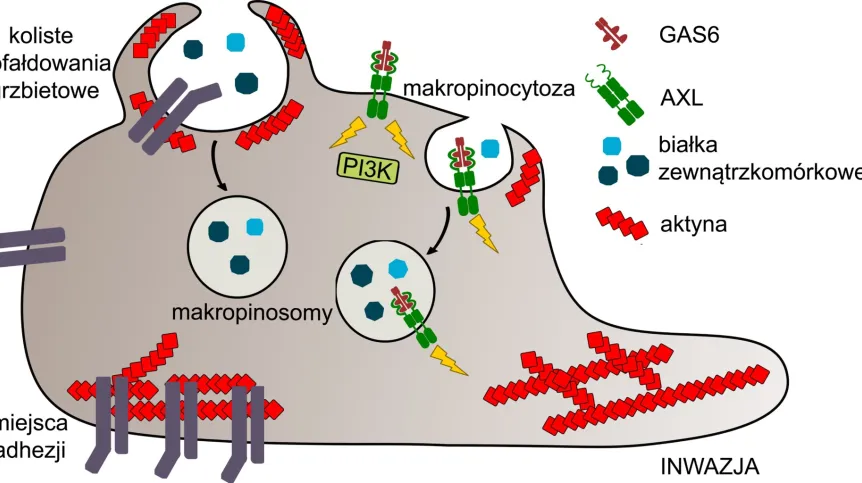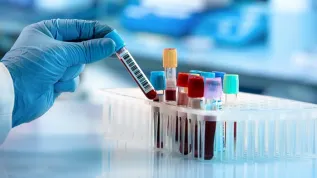
Researchers from the International Institute of Molecular and Cell Biology in Warsaw have discovered cellular processes regulated by AXL receptor, which constitutes a promising therapeutic target in the treatment of cancer and COVID-19 patients.
In a press release the institute said that metastasis, the ability of cancer cells to spread from the primary tumour and invade distant secondary sites, makes many cancers largely incurable. Despite significant progress in oncology in the last decades, metastasis still causes approximately 90 percent of cancer-related deaths.
Another important obstacle that leads to cancer treatment failure is the cancer cells' developed resistance to therapy. This phenomenon means that anti-cancer therapy ceases to work, which leads to cancer relapse and progression.
Dr. Zdżalik-Bielecka, project initiator and the first author of the paper, said: “AXL is a receptor tyrosine kinase that is associated with both metastasis and cancer drug resistance. However, despite active development of AXL inhibitors for clinical use in oncology, astonishingly little is known about the intracellular mechanisms of AXL action.”
In a recent study (https://www.pnas.org/content/118/28/e2024596118) published in the prestigious Proceedings of the National Academy of Sciences of the United States of America(PNAS), researchers from the Laboratory of Cell Biology describe the first AXL interactome and the cellular processes regulated by AXL that explain the involvement of this receptor in cancer progression and metastasis.
The study was conducted by Dr. Daria Zdżalik-Bielecka in the group of Professor Marta Miączyńska, with contributions of early career scientists: PhD student Agata Poświata and Kamila Kozik. It also involved a collaboration with Norwegian and Polish researchers from the Oslo University Hospital and the Nencki Institute of Experimental Biology.
Scientists explain that AXL belongs to the TAM receptor subfamily (TYRO3, AXL, MER). It is activated upon binding of the GAS6 ligand. Overactivation of AXL has been correlated with invasive tumour cell phenotype, metastasis, drug resistance and poor prognosis for patients. In addition, several studies suggest that AXL is involved in the cellular entry of viruses such as Zika and SARS-CoV-2.
Zdżalik-Bielecka said: “For this reason, AXL appears to be a promising target for the development of therapies also against COVID-19, further highlighting the need to better characterize the cellular processes regulated by this receptor.”
Researchers from the Laboratory of Cell Biology headed by Professor Marta Miączyńska have long been studying the mechanisms linking endocytosis and signal transduction of receptor tyrosine kinases in health and disease, including cancer.
In their latest work, the scientists identified the first interactome of AXL using proximity-dependent biotin identification (BioID) assay. The researchers discovered that AXL associates with a large number of proteins involved in actin dynamics
This finding paved the way for the discovery that GAS6-AXL signalling induced membrane ruffling, adhesion site remodeling and macropinocytosis that jointly triggered invasion of cancer cells grown as spheroids in Matrigel.
Zdżalik-Bielecka said: “Specifically, IIMCB researchers showed that AXL activation triggered peripheral membrane ruffles (PRs) and circular dorsal ruffles (CDRs). The latter were involved in focal adhesion turnover, an important process during 3D cancer cell migration. Both types of ruffles promoted macropinocytosis, an actin-driven form of endocytosis, which not only mediated internalization of GAS6-AXL complexes but also allowed cancer cells to proliferate under nutrient-poor conditions by compensatory uptake and feeding on extracellular albumin. Mechanistically, GAS6-induced actin-driven rearrangements required the activation of a lipid kinase PI3K and were dependent on AXL but not a related TAM receptor TYRO3.”
He continued: “Our study provides several novel findings with broad implications. First, the newly identified AXL interactors constitute a valuable and large resource for basic and translational research toward developing effective therapies for patients with advanced and metastatic cancers with overactivated AXL. Second, we demonstrated that GAS6 is a specific ligand for AXL and not for the TYRO3 receptor, solving long-standing discrepancies in the field of TAM receptor biology. Third, we found that the most important effect of activating the GAS6-AXL signaling pathway in the cell is the rearrangement of the actin cytoskeleton, which in turn alters membrane dynamics, substrate adhesion, cell motility and metabolism. Altogether, our study uncovers the molecular mechanisms of GAS6-AXL signaling as a pathway that promotes cancer cell invasion.”
PAP - Science in Poland
agt/ kap/
tr. RL













